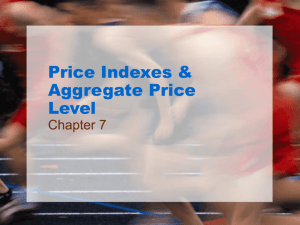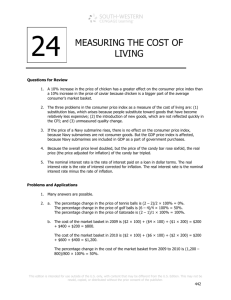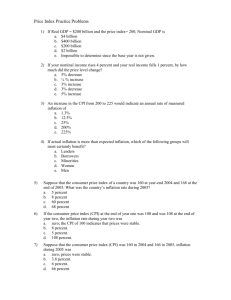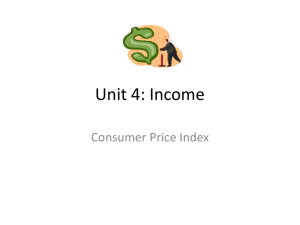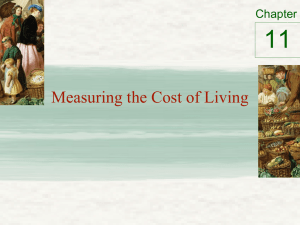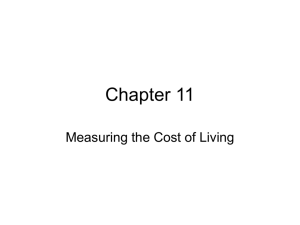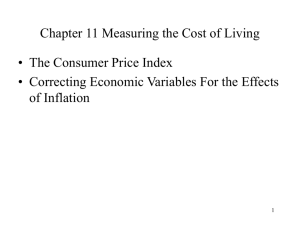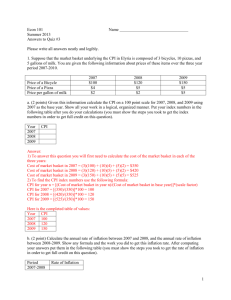Chapter 6 - FIU Faculty Websites
advertisement
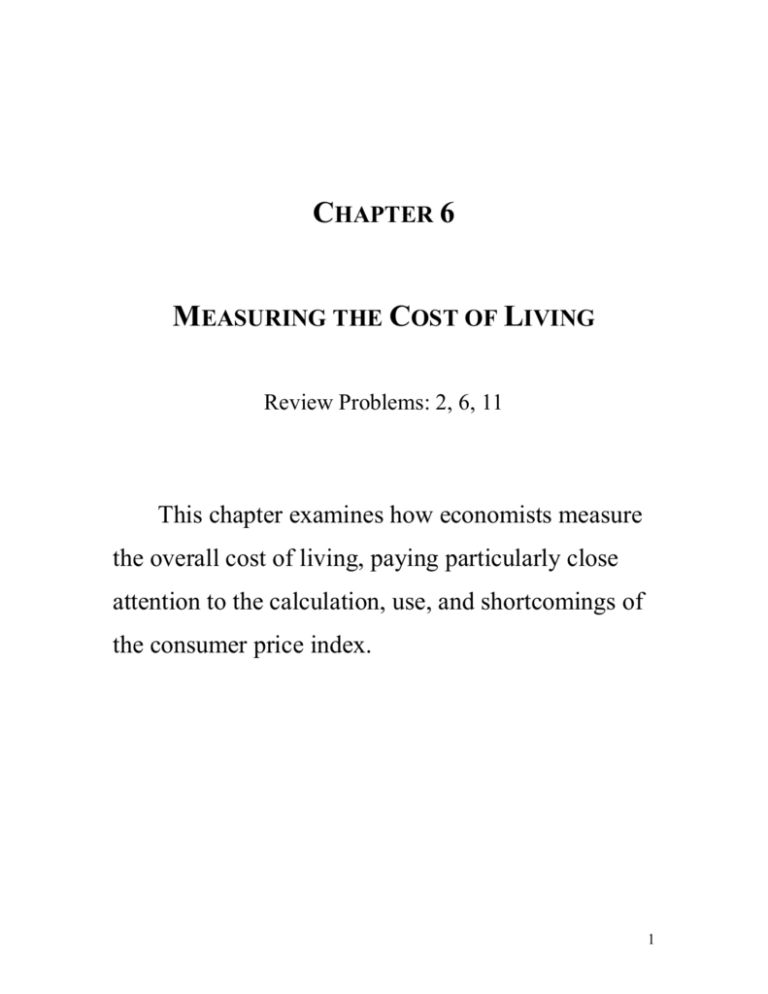
CHAPTER 6 MEASURING THE COST OF LIVING Review Problems: 2, 6, 11 This chapter examines how economists measure the overall cost of living, paying particularly close attention to the calculation, use, and shortcomings of the consumer price index. 1 Introduction Because prices go up and down over time, it is difficult to compare the standard of living with information about income only. Standard of living instead depends on the purchasing power of that income. The Consumer Price Index is a statistic which turns dollar figures into meaningful measures of purchasing power. 2 11 -1 The Consumer Price Index Definition of Consumer Price Index (CPI) – A measure of the overall cost of the goods and services bought by a typical consumer. It is computed and reported each month by the Bureau of Labor Statistics, a part of the Department of Labor. 3 How the Consumer Price Index is Calculated Computing the CPI is a five step process using data on the prices of thousands of good and services: 1.Fix the basket – Determine which goods and services are most important for a typical consumer and determine the relative importance of each. The prices of the more important ones will be given more weight than the less important ones. 2. Find the prices – Once you've established the goods, find out what the prices are now and what they were at specific times in the past. 4 3. Compute the basket's cost – Using the weights established in Step 1, determine the total cost of the basket at each set of prices found in Step 2. Note: The market basket isn't changing, only the prices. 4. Choose a base year and compute the index – Which year is chosen as the base year doesn't matter. The base year is just a benchmark against which all other years can be compared. The consumer price index for each year is the cost of the basket in that year divided by the cost of the basket in the base year, multiplied by 100. 5 For instance, an index of 150 means that this year's prices are 150% of the base year prices, or 50% higher than the base year. 5. Compute the inflation rate – The inflation rate is the percentage change in the consumer price index from the preceding period. If the index rises from 120 to 150, the inflation rate is 25 percent. Producer Price Index The Bureau of Labor Statistics also reports the Producer Price Index which measures the cost of a basket bought by a typical firm rather than a consumer. The PPI is useful in predicting changes in the CPI since firms often pass on rising costs to consumers. 6 FYI: What's in the CPI's Basket? See Figure 11. In the News: Shopping for the CPI There are 300 employees at the Bureau of Labor Statistics who gather the information necessary to calculate the CPI. This article highlights a few of these and their sleuthing methods. Another interesting fact is that the list of items in the market basket is only updated every ten years. Cellular phones currently aren't on the list! 7 Three Problems in Measuring the Cost of Living 1. Substitution bias – If the price of a good rises, sometimes consumers substitute a different good instead of buying less of the good with the new price. Therefore, the CPI may overstate increases in the cost of living. 2. Introduction of new goods – New goods mean more choices and more choices mean that the purchasing power of your dollar may go up it producers compete with each other aggressively for your business. Therefore, it is possible for you to maintain your standard of living with less money. The CPI would miss that change. 8 3. Unmeasured quality change – It is difficult to compare one period to the next because, even though the BLS tries to adjust for it, the quality of a good may change making it more or less valuable relative to its price to the consumer. In the News: The CPI Commission A 1996 commission of economists found that when the CPI changes, changes in the cost of living are overstated by 1.1%. 9 The GDP Deflator versus the Consumer Price Index Differences: 1.The GDP deflator reflects the prices of all goods and services produced domestically, whereas the consumer price index reflects the prices of all goods and serves bought by consumers. When consumers buy foreign goods or producers sell to the government rather than consumers, the indexes are different. 2. The GDP measures production of goods currently being produced, where as the CPI uses a fixed market basket of goods. 10 11-2 Correcting Economic Variables for the Effects of Inflation Dollar Figures from Different Times To compare dollar amounts in different times use this formula: Value in Year B = (Price Level in Year B / Price Level in Year A) x Value in Year A In the News: Mr. Index Goes to Hollywood Gone with the Wind is the highest grossing movie of all times, in real terms. 11 Definition of indexation - when some dollar amount is automatically corrected for inflation by law or contract. Social Security is indexed and so are tax brackets. Definition of COLA - a cost-of-living allowance which means that income is automatically adjusted to offset the effects of inflation. Real and Nominal Interest Rates Interest represents a payment in the future for a transfer of money in the past. Definition of nominal interest rate - the interest rate that the bank pays; tells you how fast the number of dollars in your bank account rises over time. 12 Definition of real interest rate - the interest rate corrected for inflation; tells you how fast the purchasing power of your bank account rises over time. Real interest rate = nominal interest rate - inflation 11-3 Conclusion Inflation reduces the purchasing power of money over time. Therefore, it is necessary to have a tool to compare dollars over time. A price index is such a tool. 13

